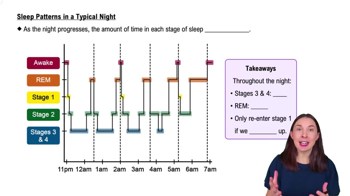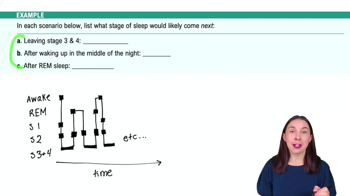Table of contents
- 1. Introduction to Psychology1h 43m
- 2. Psychology Research2h 20m
- 3. Biological Psychology2h 41m
- 4. Sensation and Perception28m
- 5. Consciousness and Sleep32m
- 6. Learning41m
- 7. Memory34m
- 8. Cognition37m
- 9. Emotion and Motivation35m
- 10. Developmental Psychology33m
- 11. Personality48m
- 12. Social Psychology41m
- 13. Stress and Health41m
- 14. Psychological Disorders44m
- 15. Treatment47m
5. Consciousness and Sleep
Sleep
Struggling with Psychology?
Join thousands of students who trust us to help them ace their exams!Watch the first videoMultiple Choice
Nightmares are more common in children than in adults because
A
children have more vivid imaginations than adults.
B
children spend more of their sleep in the REM state.
C
growth hormones are released from the pituitary during non-REM sleep.
D
children suffer from lost sleep more often than adults.
 Verified step by step guidance
Verified step by step guidance1
Understand the context: Nightmares are a type of parasomnia that occur during sleep, often causing distress and awakening.
Identify the key difference in sleep patterns: Children spend a larger proportion of their sleep in the REM (Rapid Eye Movement) stage compared to adults.
Recognize the significance of REM sleep: REM sleep is the stage where vivid dreaming occurs, which can lead to nightmares.
Consider the role of imagination: While children have vivid imaginations, the physiological aspect of spending more time in REM sleep is a more direct explanation for frequent nightmares.
Connect the information: The increased time spent in REM sleep by children is a primary reason for the higher occurrence of nightmares, as this is the stage where dreams, including nightmares, are most likely to occur.

 3:25m
3:25mWatch next
Master Circadian Rhythms with a bite sized video explanation from Hannah Gordils
Start learningRelated Videos
Related Practice


































































































![Race, Genes and IQ Differences | Bret Weinstein [Mini Clip]](https://img.youtube.com/vi/IztL_m3pd70/mqdefault.jpg)



































































































